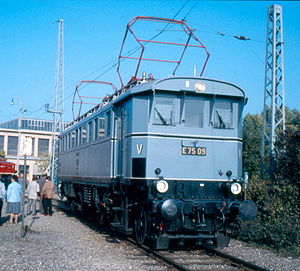DR series E 75
| DR series E 75 DB series 175 |
|
|---|---|
|
E 75 09 II on October 20, 1985 in the DB repair shop in Munich-Freimann
|
|
| Numbering: | 01-12 51-69 |
| Number: | 31 |
| Manufacturer: | mechanical: Maffei (E 75 01–12), LHW (E 75 51–61), BMAG (E 75 62–69) electrical: MSW , BEW |
| Year of construction (s): | 1927ff. |
| Retirement: | 1972 |
| Axis formula : | 1'BB1 ' |
| Gauge : | 1435 mm ( standard gauge ) |
| Length over buffers: | 15,380 mm |
| Height: | 3950 mm |
| Width: | 3050 mm |
| Fixed wheelbase: | 5300 mm |
| Total wheelbase: | 11,200 mm |
| Smallest bef. Radius: | 180 m |
| Service mass: | 106.2 t |
| Wheel set mass : | 19.7 t |
| Top speed: | 70 km / h |
| Hourly output : | 1,880 kW |
| Continuous output : | 1,600 kW |
| Starting tractive effort: | 235 kN |
| Performance indicator: | 17.7 kW / t |
| Driving wheel diameter: | 1400 mm |
| Impeller diameter: | 1000 mm |
| Power system : | 15 kV 16 Hz ~ |
| Power transmission: | Overhead line |
| Number of traction motors: | 2 |
| Drive: | Helical rod drive, Winterthur type |
| Brake: | Air brake |
| Control: | Cam switch |
The class E 75 of the Deutsche Reichsbahn-Gesellschaft was an electric locomotive for passenger and freight train service. In terms of electrical equipment, the locomotive was largely the same as the E 77 series , but was built on a one-piece vehicle frame with the 1'BB1 'wheel arrangement. It was hoped that this change would improve the running properties, but this was only slightly better than that of the E 77 and only allowed an increase in the permissible top speed from 65 km / h to 70 km / h.
history
Originally 79 locomotives had been ordered; due to the economic crisis, however, only 31 vehicles went into service. The E 75 01–12 were stationed in southern Germany, the E 75 51–69 in central Germany. In 1943, the central German locomotives (in exchange for the E 77) were also given to the Bavarian network.
That's why 22 locomotives came to the Deutsche Bundesbahn after the war . Two locomotives remained in the Soviet occupation zone, the E 75 07 was badly damaged and was decommissioned, the E 75 58 came to the Soviet Union as reparations and was no longer put into operation after it was returned. The others had been retired due to war damage, and the E 75 07, which had also remained in the Soviet zone, was one of them.
The DR locomotive was handed over to the Soviet Union and, when it was returned in defective condition, retired in 1964.
The Federal Railroad modernized the E 75 09, 55 and 69 in 1960/1961. Among other things, the locomotives were fitted with rubber-framed windows, and the side anti-glare plates on the front windows were omitted. In 1968 the 19 remaining locomotives were given the class designation 175 . Seven machines were shut down in 1968/69, the other twelve 175s were taken out of service by August 1, 1972.
Only the E 75 59 remained as the E 75 09 II and belonged to the Nuremberg Transport Museum - externally restored to its original state and with parts of the better preserved E 75 09 working . In 1987 it was shut down due to engine failure. In Nuremberg she fell victim to the fire on October 17, 2005 . It is currently in the Meiningen steam locomotive works, ready for exhibition. In September 2015 it could be viewed there as the E 75 59. The locomotive has been on display in the open-air area of the DB Museum in Nuremberg since May 2020.
Constructive features
The locomotives had a continuous plate frame that was reinforced by cross bracing. The two cast steel tubs in which the engines were stored were also used for transverse bracing. The motors were of the type BMS 700 from BEW . A Winterthur helical rod drive served as the drive . The two middle axles were driven, which were connected to the outer axles with coupling rods. The two central driving axles had flanges that were 15 mm weak. The running axles were designed as Bissel frames with 110 mm side play.
The locomotive body has end driver's cabs with extended sun protection screens without any front end. The box consisted of a profile steel frame with riveted metal sheets. Countersunk rivets were used on the E 75 01–12 and 51–61 locomotives so that the rows of rivets were not immediately recognizable. There were also other differences between the individual construction lots, for example the E 75 51-69 had intake filters for the air compressor under the frame, which, however, were again arranged differently. The pantograph was also different: The E 75 01–12 had an SBS 11, the E 75 51–69 an SBS 10.
literature
- Manfred Weisbrod, Dieter Bäzold, Horst Obermayer: The great type book of German locomotives . Transpress, Berlin 1992, 1994. ISBN 3-344-70751-5
- Horst J. Obermayer: Paperback German electric locomotives . Franckh, Stuttgart 1970. ISBN 3-440-03754-1
- Helmut Linke: Electric rod vortex . In: railway magazine . No. 1 , 2017, ISSN 0342-1902 , p. 12-26 .
Web links
- European Railway Picture Gallery
- E75 54 1959 in Munich East station on the Joachim Schmidt Railway Foundation
